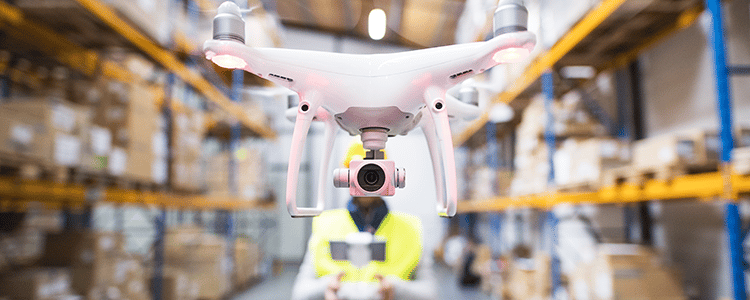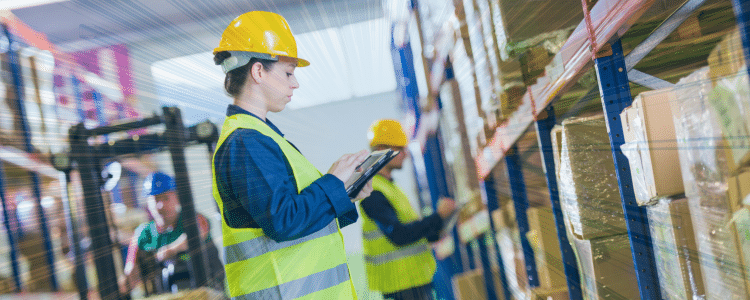As you’re considering your warehousing pain points, you may be realizing that your current software systems need modernizing. If this is the case, the next step is understanding the modern technology on the market.
Today, we’re providing an overview of the technology landscape for warehouse management automation by reviewing the latest trends in warehouse management.
The Latest Trends in Warehouse Management
1. An Increased Focus on Robotics
Robotics have weaved their way into almost every industry, especially industries involving warehouse management.
According to one report, the mobile robot market will reach an estimated $83 billion by 2032 and grow steadily over the next decade. By 2042, it will be valued at a staggering $334 billion. The ROI on robotics is so solid that even small-to-midsized companies are adopting them to make life easier at their facilities.
Among other roles, some of the most common uses for robots in the warehouse space include:
- Sorting
- Batching
- Picking
- Packaging
- Transportation
- Fulfillment
- Quality control and inspection
- Security
If you want to see this technology in action, look no further than Amazon. To date, the retail giant has rolled out more than 500,000 unique robots throughout its warehouse locations.
The Rise of AGVs and AMRs
Of course, robots in any capacity are exciting. Yet, industrial companies are looking at two specific kinds of robotic designs. These include:
- Automated guided vehicles (AGVs)
- Automated mobile robots (AMRs)
Both AGV and AMRs are scalable, easy to learn, and built to accommodate company growth. AGVs are used for transportation-related tasks, such as:
- Conveyors
- Manual forklifts
- Towing machines
- Carts
On the other hand, AMRs have a more flexible design. They’re mostly used for more intricate tasks, including moving, picking, and sorting.
Another reason to look into these robots? You can use them without making changes to your warehouse’s existing floor plan or infrastructure. This is a benefit that mobile robotic solutions have over other types of industrial robots, including automated storage and retrieval systems (AS/RS). While AS/RS can help streamline warehouse operations, these machines typically require extensive infrastructure to operate.
Other Types of Warehouse Robots
In addition to AGVs and AMRs, there are other types of robotic technologies transforming the warehouse environment. Some of the technologies to watch in 2023 include:
- Robotics-as-a-Service (RaaS) services for smaller companies
- Drones for shipping and delivery fulfillment
- “Cobots” that work together with humans to complete tasks
2024 Top 10 Manufacturing ERP Systems Report
Are you a mid- to large-sized manufacturing firm? This report is for you. Download it now to learn what kind of advanced functionality is available in the market today.
2. Creative Uses of Space
Considering warehousing trends this year, analysts also predict that warehouse rental rates will be on the rise. This is largely due to the fact that warehouse space is at such a premium. While it might seem as though companies have infinite resources to build the facilities they need, reports show that nearly 96% of existing industrial space is already in use.
Already, new warehouses are being leased even before their builds are complete. The race has become even more intense lately as supply chain issues restrict construction companies’ resources and timelines.
Where does that leave organizations that still have unmet warehousing needs? In 2023, they will need to get creative, reimagining their processes and technologies to make the best use of the space they have available.
Practices such as business process reengineering can help companies identify and correct pain points in their current workflows. In addition, warehouse management software solutions and supply chain management systems can help companies automate, simplify, and streamline manual processes that require significant space and time to complete.
3. More Plug-and-Play Solutions
In some industries, it’s easy to visualize what operations will look like a few months or even years down the road. This isn’t the case with warehousing where business needs are in constant flux.
To avoid over-utilizing or under-utilizing the equipment they invest in, companies are looking for modular, plug-and-play solutions that they can easily adapt to fit their changing needs.
These types of solutions can be complicated, so it helps to think of them as basic building blocks. Similar to a child’s toy, these blocks can be assembled or deconstructed to make something new. You can also move them around and reconfigure them as required.
These solutions are being deployed in warehouses across the country, supporting various tasks such as:
- Conveyor belt operations
- Storage
- Picking
- Sorting
4. An Uptick in Automation
Between 2022 and 2028, researchers forecast that the global warehouse automation market will grow at an annual compound rate of more than 14%.
While mobile robotics obviously fall into this category, they aren’t the only technologies making strides. Looking ahead, we expect that automation tech will become even more handheld and more personalized.
We’re already seeing this through the rise of wearable devices, such as smartwatches and tablet-equipped armbands. Warehouse workers can reference these devices to stay up-to-date on activities performed throughout the warehouse. They can do so in a hands-free manner, making the process quicker, safer, and more accurate.
Another popular automated solution is ERP software. This technology can help warehouse leaders manage a variety of internal tasks, from accounting to project management.
5. More Wireless Fleet Management
Fleet management is a concern for many industrial companies as it’s important to understand what teams are doing at all times.
Now, this task is easier than ever thanks to the always-connected Internet of Things (IoT).
This brings us to another of the latest trends in warehouse management: warehouse fleet management systems powered by wireless technology. These systems use IoT sensors that employees can access to monitor and manage vehicles right from the warehouse.
Some of the top checkpoints they can reference include:
- Driver compliance
- Driver performance
- Vehicle maintenance
- Vehicle status
Real-time fleet reporting can help companies conserve costs through constant process monitoring. Companies can also leverage these systems to improve their internal safety metrics and increase customer satisfaction.
The Key to Improving Warehouse Management
These are only some of the transformations taking place within warehouse management. Other growing technologies to watch include RFID tagging, IoT/AI analytics, cloud-based software, and blockchain technology.
Do you want to learn more about the latest trends in warehouse management and what they could mean for your organization? If so, we can help. Our ERP selection consultants can help you select technology that optimizes every corner of your warehouse. Contact us below for a free consultation.













